| Photojournal
- 10 June
2005
Down
on the farm
|
The 10th of June was
a pretty special day. I had a standing offer from a friend, photojournal
reader, and bird biology researcher named Oliver to come and visit
him at his field site, and I was determined to go visit him before
I went back to work after the time off for surgery. I was feeling
pretty good on the 10th, so I headed to Oli's site, which was
at a dairy farm in the eastern part of Surrey.
Oliver had given me
a good set of directions, and the place was easy to find. Right
after pulling in, I encountered the farmer who owns the farm,
a big and quite friendly guy. After ascertaining that I was one
of the "bird people," he pointed me towards a trailer
out behind the barn. The trailer served as the field station for
Oliver and a few other researchers.
On my way over to the
trailer, I encountered a dead animal. If you don't mind such subject
matter, clicking here should take you to my
photo.
I found Oliver in the
trailer with his two assistants. They were busy at a computer
working on some experimental data. Despite my arrival being a
bit unexpected, Oli took a fair bit of time out and showed me
around the farm. I didn't do much picture-taking while he was
showing me around, because the plan was for him to give me a tour
and then let me wander as I would. We were both hoping to be able
to spend more time together (two bird enthusiasts...) but Oliver
had work to do.
Anyhow, once Oli had
shown me around, I decided on a trip through a row of cattle stalls
and then to walk around the edge of a nearby field, where Oli
and co. had erected a line of nest boxes for the European Starlings
that they were studying.
I didn't do any photography
of the cows in their stalls, as there were a few people around
and despite Oli having assured me that it was okay for me to be
walking around and photographing things, this was those folks'
workplace and I didn't want to disturb them.
Besides which, the
cows were watching me pretty carefully as I went through there.
I didn't want to disturb them, either.
But right at the end
of the stalls, I couldn't resist taking photos when I caught sight
of the following little lady calico. This was a proper farm, after
all—it had lots of farm cats. Oliver didn't think
that anyone had a name for this one, who was a little bit camera
shy.
|
|
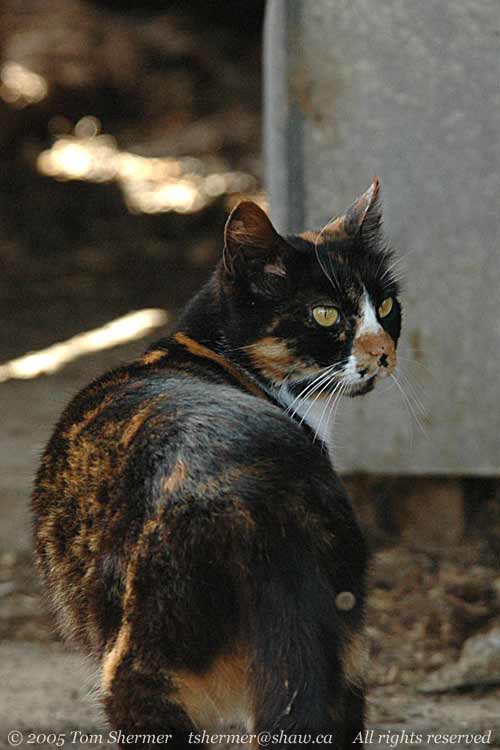 |
| Another
feature of any proper farm is piles of stuff here and there.
This farm didn't disappoint on that count; here's a shot of a good
pile of rusted metal stuff. |
|
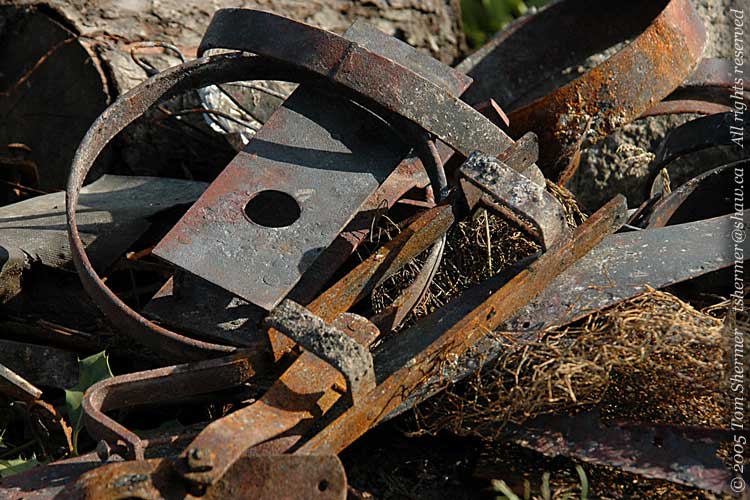 |
| Well, I
walked the edge of the field, which is bordered by some woods around
a stream. It was the afternoon, and the sun was really out, and
it just wasn't a good time to find much bird life. I saw a few robins
along the ground and the occasional starling. I was carrying a backpack
with all my new lenses in it, and I stopped in front of this tall
tree to switch to my wide-angle. |
|
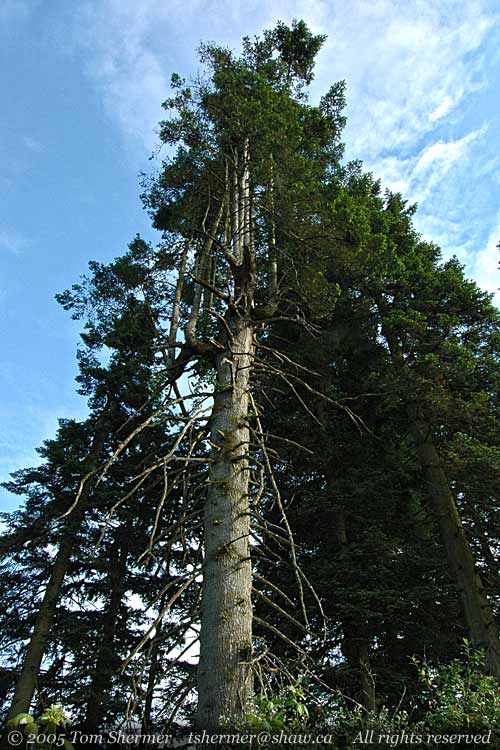 |
|
That tree was pretty
cool. The bottom part was a tree that had broken off pretty far
up there, about halfway up the photo. That part looked to be a
Grand Fir. From where it had broken, other trees (of an entirely
different species) had started growing; some grew straight up
and some grew outwards from the main trunk and up. These trees
looked to be Cottonwoods of some sort. You can see their whiter,
thinner trunks as the top half of the tree.
When new trees grow
out of the decaying body of an old tree, the old tree is called
a nurse log for the new ones. Usually, though, nurse logs
are fallen trees, not standing ones.
After taking lots of
shots of that tree, I drank some water from a bottle I was lugging
around and almost-reluctantly put my long lens back on the camera.
I hadn't seen much to aim that long lens at, and I was thinking
that maybe I should just leave a shorter lens on and concentrate
on scenics or whatever. But one of the first rules of thumb for
wildlife photography is to keep the long lens on the camera by
default. Subjects that require wider angles are often like that
tree above—they don't fly away while you're changing lenses.
Subjects that require
narrower angles are typically the smaller, more mobile things.
Sorta like the next thing that caught my eye: the unmistakable
zip-and-stop of a hummingbird in flight. Since I had that long
lens on, it was a simple matter of point the thing at the bird,
focus, and shoot. I actually ended up with focus on the leaves
behind the bird, so it's not the best shot in the world, but I
wouldn't have gotten a shot of this lady at all if I'd've had
the short lens on.
|
|
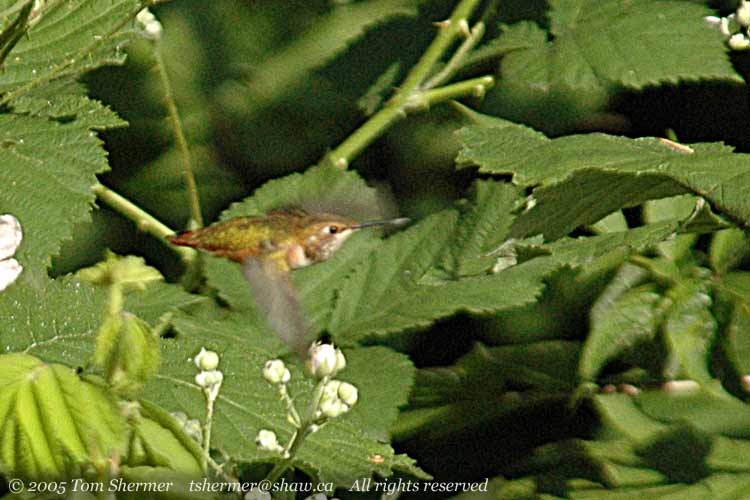 |
|
Sometimes the extra
effort to stay prepared pays off.
But it didn't pay off
that much, and I didn't find any other subjects until I was all
the way around the field back by the barn. There I caught a couple
of starlings up on a light on a stanchion.
|
|
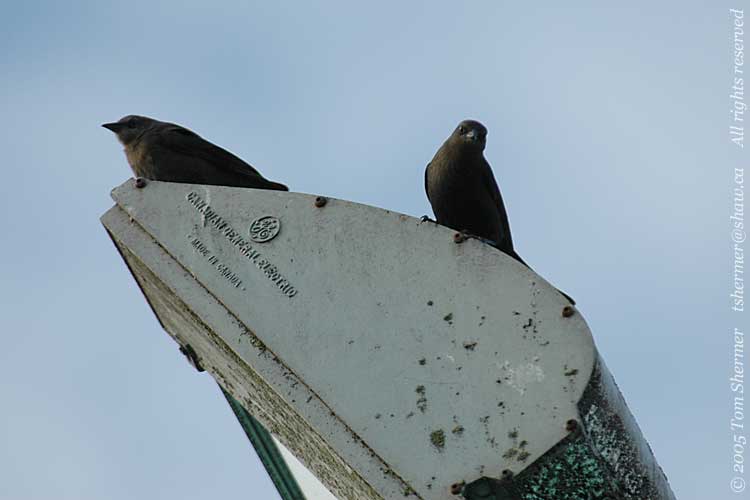 |
| I shot starlings
for a while, and caught this little beauty up on a wire. All that
jewelry she's got on is Oliver's doing. He's always giving his little
lady-friends bracelets. This girl, he told me, is probably the one
from box 15, and the yellow-and-pink on her left leg identify her
as being in a particular one of four experimental groups he had
this year. |
|
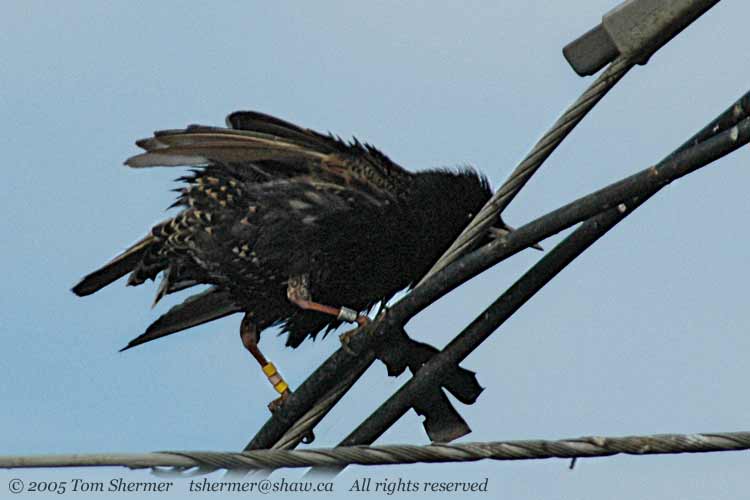 |
|
I headed back over
to the trailer to see if Oliver was still around, and right before
I got there I encountered this friendly little fellow. He's called
Joe, and he hangs out with the bird people. He's pretty devoted
to them.
Joe will wait outside
the trailer for Oliver and crew to show up in the morning, and
hang out with them all day. (That can be a long day, too—Oli
often need to be there in the wee hours, like 4am, when it's just
before sunrise and the starlings haven't yet had their first cup
of coffee). Joe will even accompany the bird folks to make sure
that nothing untoward happens to them when they go around the
farm to check all of the nest boxes. He's just that kind of guy.
|
|
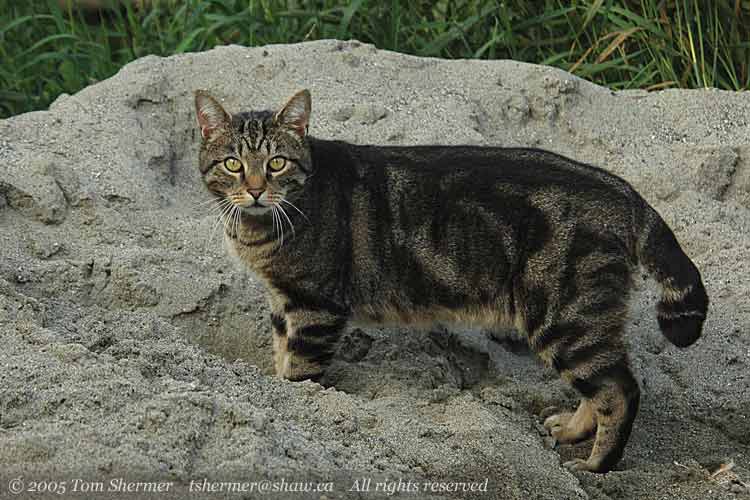 |
| It was now
after five, and Oliver had left for the day. None of the farmhands
were around, either, so I was able to get a few photos of the cows
without feeling like I was intruding. Here's my favorite. |
|
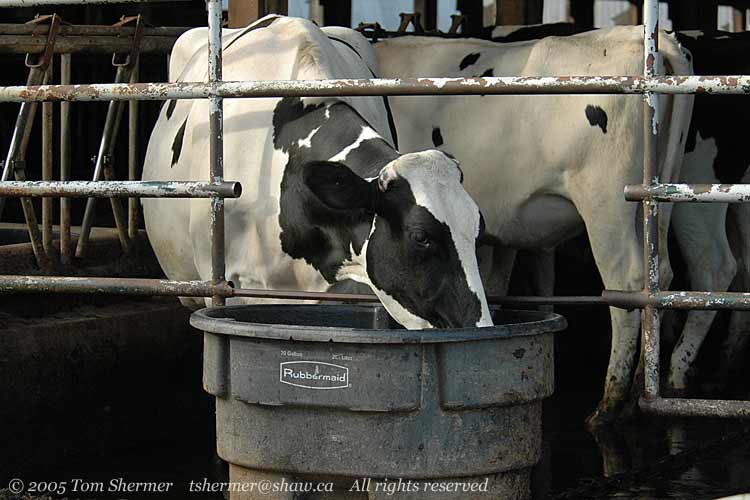 |
| I went over
to a shed where Oli had shown me a few things up in the rafters,
and tried to get shots of them. Here there's a Barn Swallow on the
chain; above the swallow is a dirty white light fixture. On top
of the dirty white light fixture is a little way of mud, remnants
of an old Barn Swallow nest. They like to put their nests on top
of these lights affixed to the side of a beam. Maybe it's because
they get a little extra warmth from the bulb, or maybe its just
because it's a neat little shelf that's hard for predators to get
to. Either way, there were lots of old swallow nests on the light
fixtures. |
|
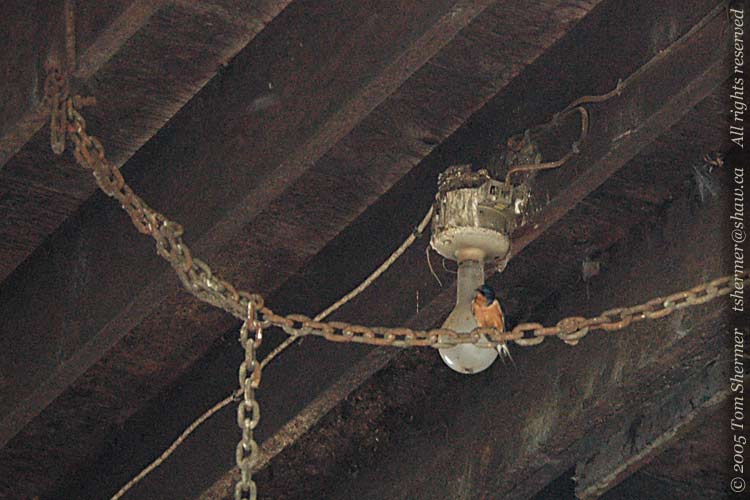 |
| In a newer
shed, there was a robin's nest up in the rafters. Oli had pointed
out a few nearby partial robin's nests, where the robin had started
building but got confused or changed their mind about the nest site.
There was an adult robin up in that nest, but she didn't raise her
head to give me a good photo. |
|
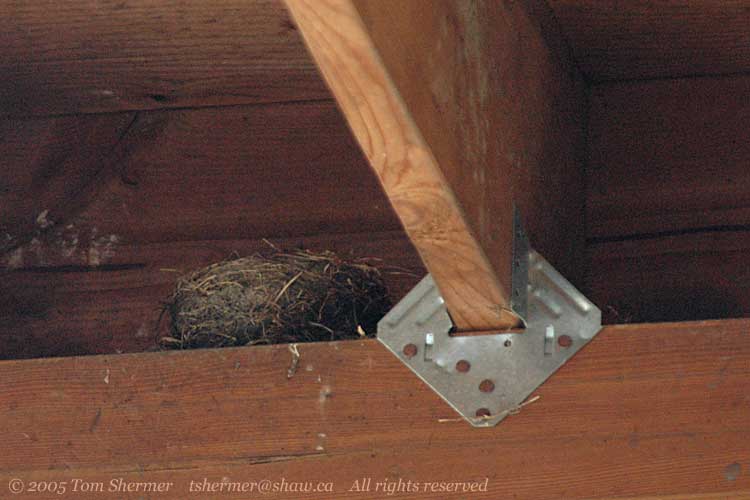 |
| Nearby,
I caught another Barn Swallow. I'd always thought of the orange
on Barn Swallows as a fancy display color. Now I'm beginning to
think it could serve as camouflage, too. |
|
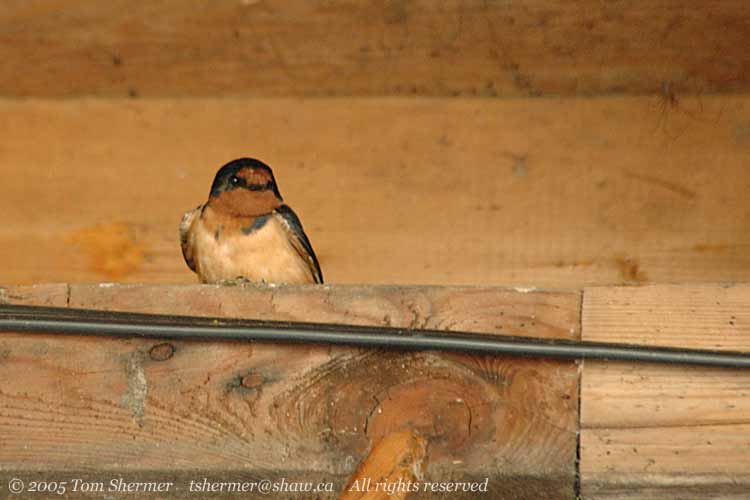 |
| On the other
side of the shed, there was a Rock Dove at a nest. Note how messy
and flat the dove's nest is compared to the neat cup of the robin's. |
|
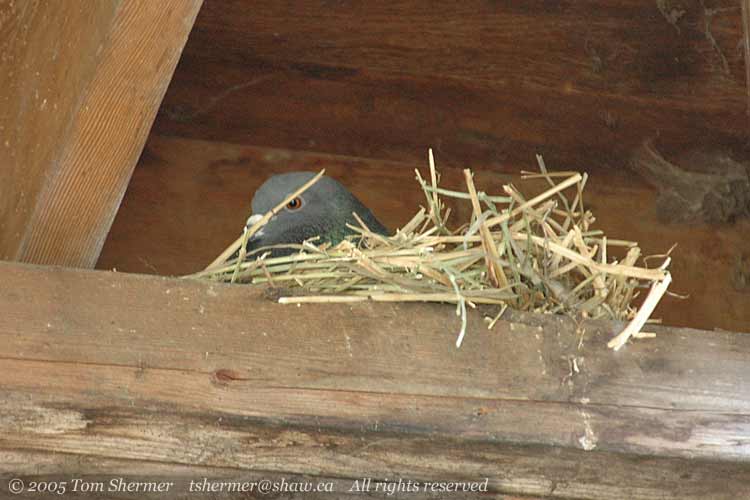 |
|
Well, that about did
it for me at the farm. I hopped in my car and started driving
out the dead-end road that leads to the farm. I stopped when I
saw this bunny at the side of the road, though. I didn't dare
open the car door, so I took this from the driver's seat with
the window rolled down. This guy is a Snowshoe Hare, our indigenous
hippity-hoppity fellow.
|
|
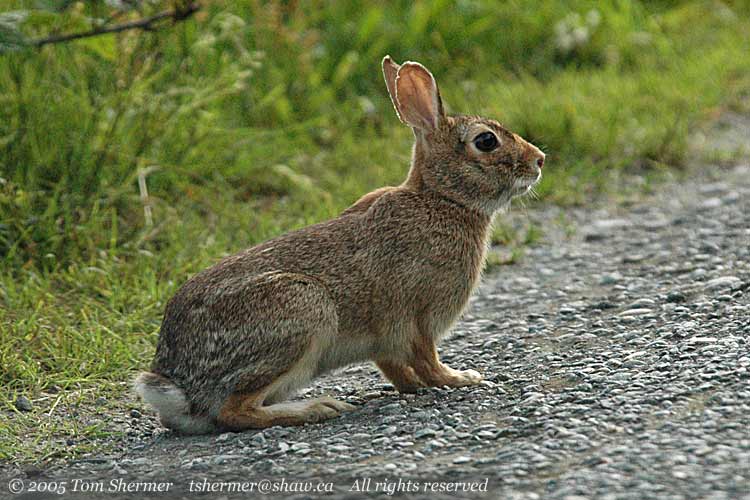 |
| Later, when
I got back home, it was still fairly bright, so I tried a few more
experimental shots with my wide-angle. In this shot, I was trying
to get the duck (middle right) in the close foreground of the photo,
but she was pretty wary and didn't swim near. |
|
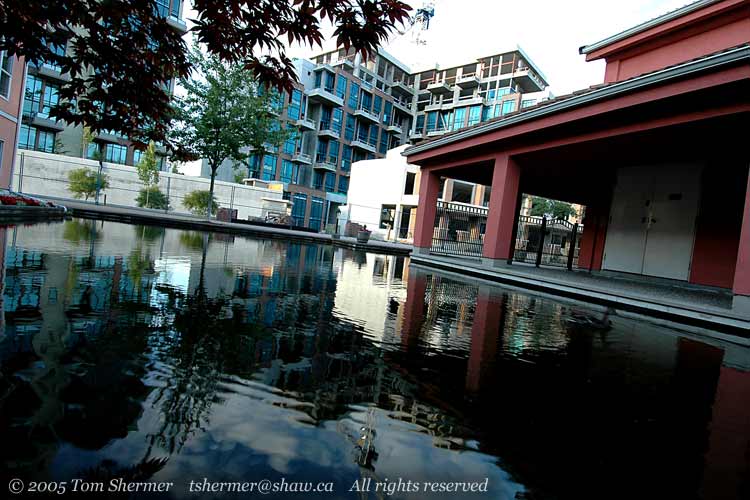 |
| Here's another
one, showing the extreme range of darks and lights I had to contend
with. I liked the deep blue of the reflection of the sky and the
salmon-colored tower above its reflection. I don't know why I was
holding the camera tilted like this, although this would be one
very boring shot if everything was straight up. |
|
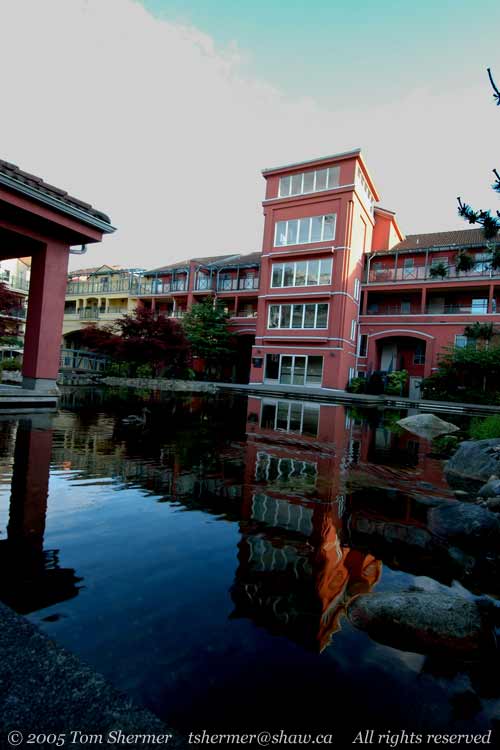 |
|
I had hoped to see
more birds at the farm, but realistically that meant getting up
for early morning, which was very early at this time of the year.
(And so, knowing me, not very likely.) On the other hand, there
were lots of cool cats and cows and farm stuff around there, and
so I still had a grand time there. I was happy that I had taken
the time to get there before going back to work.
I'd like to thank Oli
for having me out there and showing me the cool stuff, and my
friend Margo for help identifying my nurse tree and its charges.
Until we meet again,
Tom
|
|
|